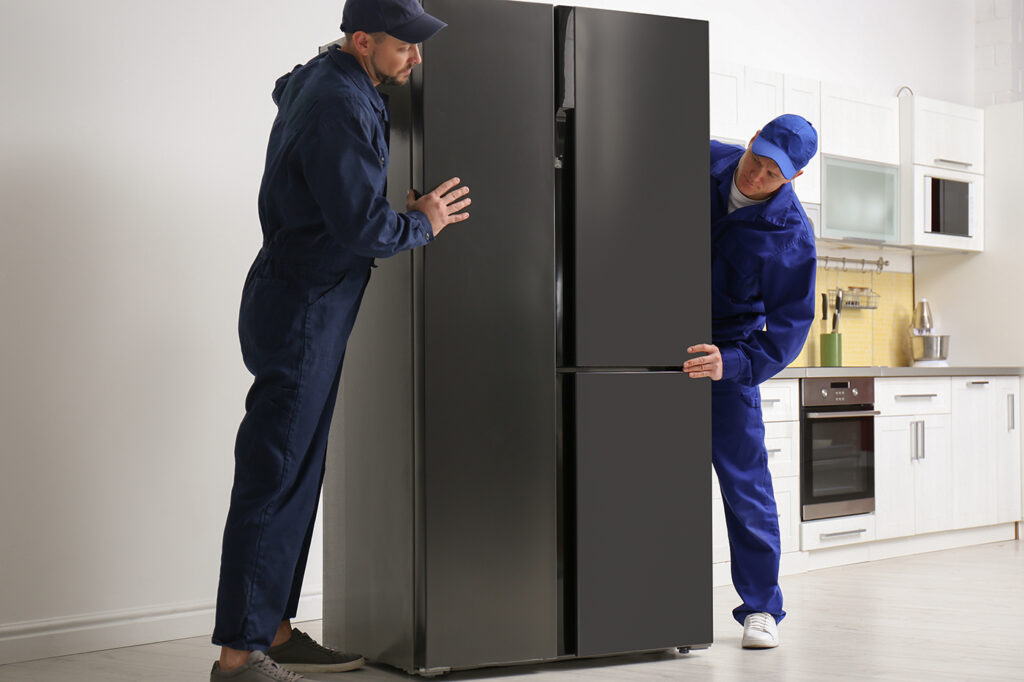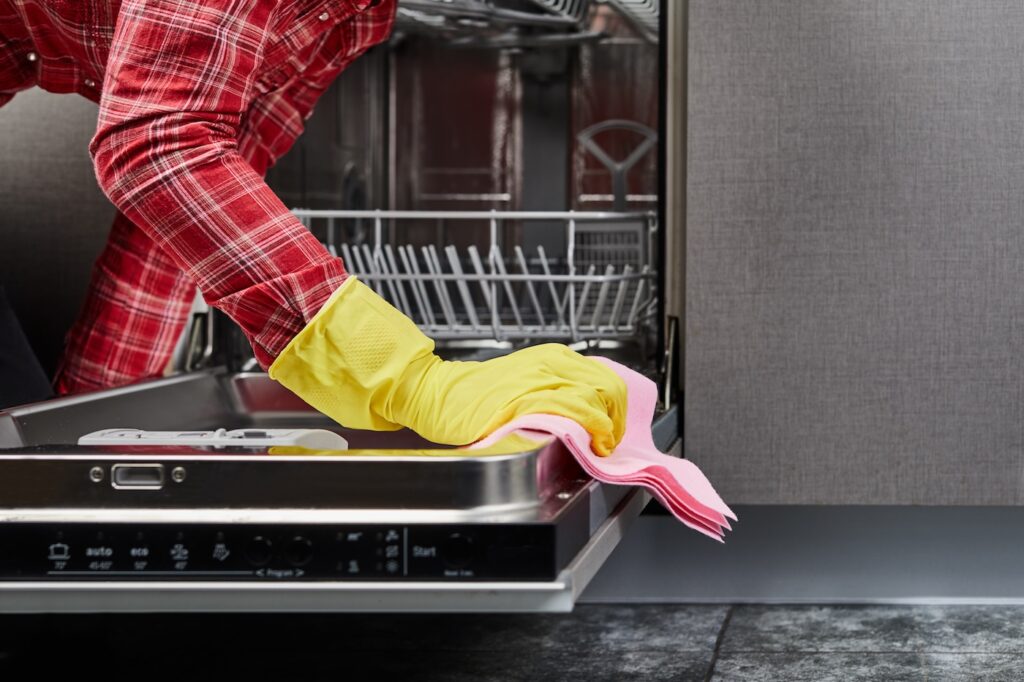The basic problem with moving a refrigerator is its sheer weight. An average refrigerator weighs about 400 lbs—to put that in perspective, that’s the weight of a grand piano or a young adult grizzly bear. Just like moving a bear, moving a refrigerator can be a dangerous beast. What you might not have considered are the myriad of other issues that can occur during the moving process, such as unplugged fridges leaking water and collecting mold or mildew, the potential for destroying floors and scratching walls, and the greater risk for injury if you attempt to move it yourself. But have no fear! This guide walks you through all the necessary steps to efficiently and safely move your fridge and freezer when relocating to a new home.
Supplies Needed for Moving a Refrigerator

Before you even think about moving your refrigerator by yourself, through a moving company, or using DIY methods, you’ll need some tools to get started. The following is a list of tools and materials that you will need to move your refrigerator.
Materials
- Moving blankets/pads
- Bubble wrap
- Bungee cords
- Tape or rope
- Plastic or old sheets (optional, for floors)
- Cooler and ice packs (for food storage during move)
Tools
- Appliance dolly with straps
- Measuring tape
- Screwdriver set or drill
- Work gloves
- Furniture sliders
- Minimum of two able-bodied people
How to Move a Refrigerator in 8 Steps
Follow the below instructions to stay safe and move your fridge efficiently.
1. Empty the Fridge

Start by removing all food and loose items from your refrigerator. Discard any perishables, and pack non-perishables in coolers with ice to keep them cold during the move. This prevents spills and lightens the load.
2. Disconnect the Fridge

Next, you’ll need to fully disconnect the refrigerator from its power source (typically a wall outlet for standard home fridges) and detach it from water lines if it’s a fridge with an ice maker or water dispenser. Also be sure to remove any screws or brackets securing it in place.
3. Measure, Measure, and then Measure Again

Measure the fridge and house doorways. Use a measuring tape to note the dimensions of your refrigerator and the width of all doorways and hallways it needs to pass through. This determines if you need to remove the fridge doors or adjust the moving plan.
Note: Measuring is essential. Ideally, measure before you start taking the doors off and throwing all your food away.
4. Remove Doors, If Necessary

If the fridge won’t fit through any doorways or hallways, you’ll need to remove the doors. Consult your owner’s manual for specific instructions on properly detaching and reattaching the doors for your side-by-side or french-door model.
5. Protect the Floors

Protect the floors and doors. Line pathways with moving blankets, plastic sheets or old rugs to create a clear path and prevent damage to floors. Also cover door jambs with moving blankets to avoid dents and scratches.
6. Prep the Fridge

Prepare the unit for moving. Secure the refrigerator door(s) closed with moving straps, tape, or rope. You may also want to secure moving blankets around the exterior to protect its finish during transport.
7. Plan for Transporting the Refrigerator

Before lifting the fridge, identify your path of travel and make sure it’s clear. Use an appliance dolly with security straps to load and transport heavy fridges. You’ll need at least two strong people to safely lift and guide the appliance. If moving into a tight space, consider renting a pickup truck or moving truck with a ramp to move the fridge forward at a 45-degree angle.
8. Move the Refrigerator

Move the refrigerator with one person guiding the front and another pushing from behind, carefully navigate the refrigerator through doorways and onto its new location. Go slowly, and communicate well. Don’t try to force the fridge if it gets stuck. Professional movers have the right equipment and experience for transporting large appliances like refrigerators.
Moving Refrigerator Up/Down Stairs

Maneuvering a bulky refrigerator up or down flights of stairs presents some unique challenges. For utmost safety, keep these tips in mind:
- Having adequate manpower (3-4 people minimum): An extra set of hands is absolutely essential for stair navigation. Attempting this with just two people greatly increases risks of injury or property damage.
- Use shoulder dolly straps properly: Equipping your moving team with shoulder dolly straps allows you to securely lift and cradle the refrigerator’s weight through staircases.
- Angle the fridge, and take corners slowly: Getting the right diagonal angle is key to making stair turns. Communicate clearly and take curved steps slowly to avoid impacts.
- Lifting vs pushing up/down stairs: Lifting is required for going upstairs, while downstairs the approach is slow, controlled pushing/walking to guide the appliance.
- Potential for damaging stairs/walls: Have movers cover balusters and wall corners, and use caution. Dents, scrapes, and even stair collapse are real risks that can happen if you don’t take proper care.
Properly Preparing the Refrigerator for the Move

Taking the proper precautions to prepare your refrigerator for transport is crucial to prevent damage and make the lifting and loading process easier. Here are the key steps:
- Remove all shelves, bins, and other removable parts: Take out every shelf, drawer, bin, and any other removable components from both the fresh food and freezer sections. This reduces the overall weight and makes the unit less cumbersome to maneuver.
- Secure loose items like condiment racks: Items like condiment racks that are attached to the door need to be secured so they don’t swing free and get damaged. Use packing tape or bungee cords to hold them tightly in place. Additionally you can also use large plastic bags. Be sure to label everything you take apart.
- Wrap glass shelves in padding: The glass shelves from the interior should be carefully wrapped in moving blankets or bubble wrap to prevent shattering during jostling.
- Tape the doors shut: Once empty, taping or strapping the refrigerator and freezer doors closed prevents them from swinging open accidentally.
- Cover vents/openings with plastic wrap or masking tape: Any vents, drains, or openings on the exterior should be sealed off with plastic wrap or masking tape to keep out dirt, debris, and pests.
- Use bungee cords or ratchet straps to keep doors securely shut: For added security, use heavy-duty bungee cords or ratchet straps to firmly bind the refrigerator doors closed during the move.
After the Move: Reassembling and Restarting

With the refrigerator safely transported to its new home location, take the time to properly reassemble and prepare it for use. Let the fridge reset for 2-4 hours before restarting, this allows the compressor fluids and gasses to fully resettle after being moved around during transit before plugging in and restarting. Finally If your refrigerator has a water dispenser or ice maker line, it’s recommended to install a fresh new filter.
How to Move a Fridge FAQs

Can you lay a refrigerator down to transport it?
No, refrigerators should always remain upright when moving. Laying a fridge on its side or back can allow coolant and lubricant to leak out of the compressor, causing permanent damage.
How much time should you wait between unplugging and moving?
Most manufacturers recommend waiting at least 24 hours after unplugging before attempting to move or transport a refrigerator. This allows the refrigerant gasses to settle properly.
Is there a waiting period before restarting the fridge?
Yes, you should wait at least 2-3 hours after moving and plugging in a fridge before restarting it. This stabilizes temperatures and pressures so the compressor doesn’t get overloaded.
How to transport a fridge by myself?
It is extremely inadvisable to attempt moving a refrigerator alone. Their extreme weight and awkward shape poses a very high risk of injury or property damage without adequate help.
How long should a fridge be off before moving it?
For most standard fridges without water/ice lines, allowing the fridge to fully defrost for 24 hours before moving is ideal. This prevents water leaks and condensation buildup.
Can you lay a refrigerator on its side?
No, you can’t. Fridges should never be laid on their side, as this risks damaging the entire unit.
Should I clean out the fridge before moving?
Yes, be sure to thoroughly clean out the refrigerator interior with baking soda, and remove the water filter before transporting. This prevents odors and reduces the weight.
When to Hire Professional Refrigerator Movers
If you are unsure about doing the job yourself, here are some common scenarios where using a professional moving company is advisable:
- Lack of manpower: If you don’t have at least 2-3 able-bodied assistants, hiring pros is highly recommended for an appliance as heavy as a refrigerator.
- Extremely heavy models like sub-zero, built-in units: Higher-end refrigerators can easily surpass 600 lbs, requiring specialized equipment and training to move properly.
- Accessibility issues like tight spaces or multiple staircases: Pros have experience maneuvering fridges through even the most cramped areas and up/down winding staircases.
- Lacking proper moving equipment like dollies, straps: Don’t risk back injury by trying to muscle a fridge without an appliance dolly and strapping.
- Moving across long distances: For long-distance refrigerator transport, professionals bring the right hauling trucks and can pack it securely.
- Peace of mind to avoid injury/damage: Perhaps most importantly, pros can give you confidence that the pricey refrigerator (and surrounding areas) won’t get damaged.
Avoid Trouble, Hire a Tasker to Do the Job!
As you can see, moving a refrigerator involves extensive preparation, specific techniques, proper equipment and ideally, at least two able-bodied movers to do it safely. One wrong step and you risk throwing out your back; damaging floors, doors, or walls; and—worst of all—destroying your refrigerator entirely. Why risk the headache and potential harm when you can easily book professional refrigerator movers with Taskrabbit?
Sourcing boxes, pricing movers, going to the donation store—you have enough to do with moving day approaching anyway! With just a few taps, you can connect with highly-rated refrigerator movers in your area equipped to handle every step of the fridge relocation process. Taskers bring all necessary equipment like appliance dollies, ratchet straps, furniture pads, and moving blankets, as well as the muscle, power, and expertise to execute the job properly and make sure your expensive appliance arrives at its destination safely and ready to plug right in. Don’t waste time and risk injury struggling with your weighty ice box— let a Tasker give you a truly cool moving experience instead.














